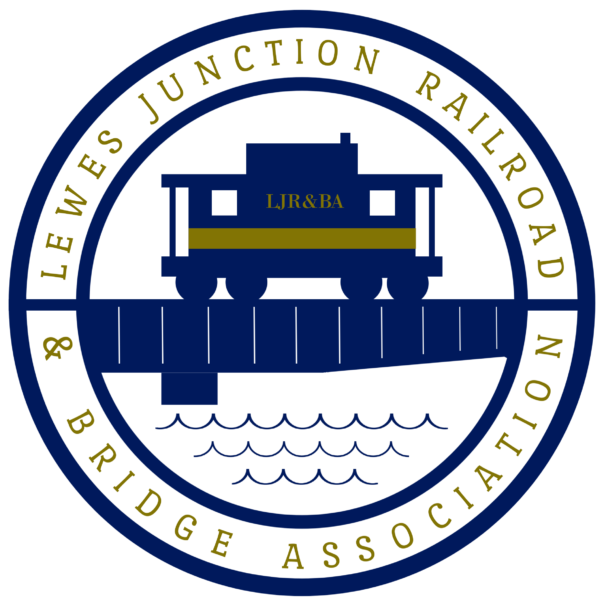The Junction & Breakwater Railroad originally constructed the right-of-way between Lewes and Rehoboth Beach during the 19th century. In the following years, the system became part of the growing Pennsylvania Railroad (also referred to as both the PRR or “Pennsy”), which would eventually operate most of the rail lines in the state of Delaware. While the corridor primarily served as a branch line, it did handle respectable levels of freight and passengers through the first half of the 20th century. As highways improved, rail traffic slowly declined to the point that the line was abandoned in sections during the 1970’s.
The Pennsylvania Railroad was rapidly growing during the late 1800’s. Its strategic dominance in the Northeast was thanks in large part to its ownership of the Philadelphia, Wilmington & Baltimore Railroad (PW&B) in which it acquired a controlling interest on March 7, 1881. Interestingly, this concluded a fight with the Baltimore & Ohio, which had also tried to acquire that railroad. The PW&B had been formed in the late 1830’s and eventually became a vital transportation artery serving all three of its namesake cities. By 1838, it had initiated rail service to Wilmington, Delaware, and greatly opened the state to further expansion and growth. Early on, the state legislature attempted to see rails laid to the downstate counties by granting charters; however, lack of private investment and interest resulted in no construction throughout the early 1850’s.
Finally, the state stepped in to fund the Delaware Railroad (DERR) in 1852, which received financial backing from the Philadelphia, Wilmington & Baltimore. It went on to lease the new company in 1855.
Beginning at Wilmington, the DERR struck out southward for Dover, opening service there by 1856. The system had reached Seaford later that year, and in 1859, was completed to Delmar at the state line. Here, it offered an interchange with the Eastern Shore Railroad based in Maryland.
In 1857, the Junction & Breakwater Railroad (J&B) was chartered to build from a connection with the Delaware Railroad at Harrington and head toward the Atlantic coast. The J&B was a subsidiary of the Old Dominion Steamship Company and was envisioned to operate in junction with steamship service between the Delmarva Peninsula and New York. In 1859, the J&B had reached Milford (8.3 miles), but further construction was put on hold until after the Civil War. Work resumed in 1867, and the line was completed to Lewes, via Georgetown, by 1869, with service opening to Rehoboth Beach in 1878. The entire route (Harrington to Rehoboth Beach) was 43.8 miles long.
The Dominion Steamship Company also owned two allying systems, the Breakwater & Frankfort Railroad and Worcester Rail Road, which had opened service to Franklin City, Virginia, by 1876. During May 1883, all three merged as the Delaware, Maryland & Virginia Railroad (DM&V) and was acquired by the Philadelphia, Wilmington & Baltimore two years later. Over time, the PW&B properties and others the PRR owned in Delaware were brought under common operation and known as its Delmarva Division. Also sometimes referred to as the “Delmarva Lines,” this part of the Pennsy network reached throughout downstate Delaware, along the Eastern Shore of Maryland, and into the eastern tip of Virginia.
The lines in this region, like those constructed by the Junction & Breakwater, greatly opened the Delmarva Peninsula to commercial growth and development. Southern Delaware offered natural resources in timber, and fertile soil which meant that crops could be shipped to northern markets at greater profit thanks to the railroad’s much faster transit. For instance, according to the Delaware Department of Transportation’s history of the state’s railroads, Kent County’s peach crop soared from $10,000 annually to $500,000 within just 20 years after rail service was initiated. Rehoboth Beach, founded in 1873 by the St. Paul’s Methodist Episcopal Church as a site for camp meetings, grew into a popular resort and vacation destination for the general public, drawing in thousands of visitors annually.
Passenger service on the branch to Rehoboth Beach remained relatively strong until the Great Depression. A brief rebound occurred during World War II, but improved highways and automobiles after the war caused the PRR to end remaining service across much of its Delmarva Division by 1950. Freight service continued after this time, but the railroad slowly cut operations when traffic dried up. During 1968, the PRR merged with the New York Central, forming the ill-fated Penn Central (PC). Incredibly, after just two years in operation, PC declared bankruptcy in 1970. The conglomerate was a poorly conceived merger that stood no chance of success, considering the opposite philosophies and management styles of the two former railroads.
A few years after entering receivership, the Penn Central was able to abandon 5.5 miles between Lewes and Rehoboth Beach, which now forms the Junction & Breakwater Rail Trail. The rest of the line from Lewes to Georgetown survived until Conrail formed in 1976 to preserve rail service in the Northeast. While the new carrier, officially known as the Consolidated Rail Corporation, (Conrail) did not retain this section, it was eventually purchased by the State of Delaware and was leased to Delaware Coast Line Railroad. Once again declining traffic and a major deficiency on the historic swing bridge over the Lewes and Rehoboth canal forced closure of the rail line forever. In 2017 the tracks were removed and in 2022 the historic swing bridge was removed.
The Lewes Junction Railroad & Bridge Association was established in July 2019 to preserve, display, and interpret the railroad heritage of Lewes and Eastern Sussex County, Delaware, in an authentic and appealing setting for the education and enjoyment of the public.
